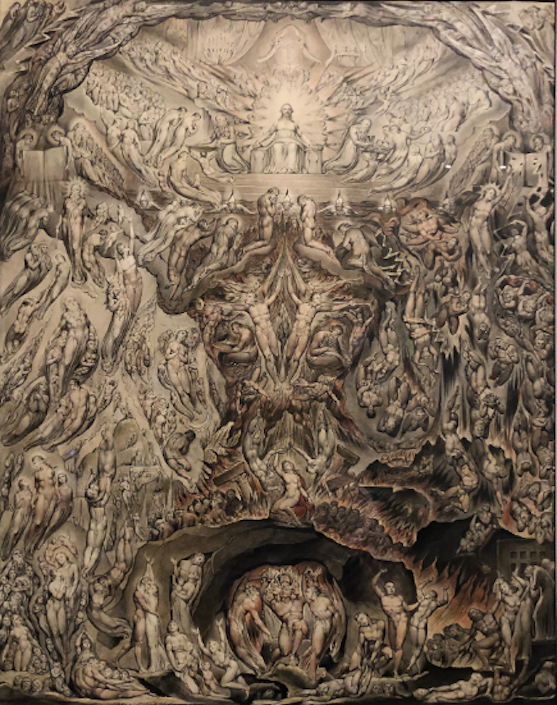William Blake: Between Imagination and Reason
William Blake, Self-Portrait, c. 1802, monochrome wash drawing, dimensions unknown
William Blake is often described as an artist, poet and printmaker, but most of all he was a philosopher. The Marriage of Heaven and Hell is an illuminated book he composed between 1790 and 1793 in which he explains, among other ideas, his theory of contraries.
Opposed to each other in Blake’s conception of the world are Imagination and Reason. For Blake opposites are the fundamentals of human existence. This cornerstone of his philosophy transpires not only from the illustrations of his book, but from many of his drawings and watercolors.
William Blake, A Vision of the Last Judgement (c.1808) is a watercolor crowded with figures. In the top section sits God, on his right the saved, on his left the damned.
William Blake, A Vision of the Last Judgement , c.1808, waterolor. On Christ’s right are the saved, coupled in affections of love, who spiral upward toward Christ. On Christ’s left are the damned, isolated in their fear and anguish, who fall downward into the torments of hell.
The ascension to Heaven of the righteous is created by spires of clouds lifting up the bodies of the saved. The saved are grouped together, enveloped in veils. The souls ascending to God represent Blake’s idea of “man friendship”.
Left and Right: William Blake, Details of the section of the saved from A Vision of Heaven and Hell, ca. 1808, watercolor. In this section of the saved, to the lower right of Christ, are numerous figures, spiraling upward towards Heaven, embracing and affectionately showing love.
The representation of the saved souls is charged with physical intimacy. A few of the righteous are couples, represented with their arms around each other’s body, looking into each other’s eyes. Blake condemned “unacted desire” as the greatest crime, he wrote: “He who desires but acts not, breeds pestilence”. On the right of the throned Christ, sitting on a cloud, two small figures hugging and kissing recall once again the very intimate nature of humanity.
William Blake, Detail of A Vision of Heaven and Hell, ca. 1808, watercolor. In this section of the saved, above Christ’s head, are two people kissing.
The damned are all singular figures. Hell, according to Blake, is something that we construct ourselves when we close ourselves off from other people. The bodies of the cursed are contracted in unnatural positions, fighting with each other and chained. The falling figures grab each other’s heads, pull their hair, sorrowful with their heads in their hands, drag each other down. Violence, as opposed to togetherness, permeates this side of the image.
Left and Right: William Blake, Detail of the damned from A Vision of Heaven and Hell, ca. 1808, watercolor. In this section of the damned, on Christ’s left, are people undergoing extreme torment as they fall to their sorrowful fate.
The culmination of Blake’s theory of contraries can be found in the outlook of the composition. Reason and Imagination, one male, the other female. The shape created by the ascending and fallen souls and by the different shades of watercolor, suggests on one hand a head, on the other a uterus. The head, symbol of Reason, with God residing in the oversized brain. This matches Blake’s idea of the Messiah as Reason, the Governor who restrains desire and Imagination. The uterus represents the opposite of the masculine Reason, it is the feminine Imagination. The greatest achievement of the image, overlooked by scholars, is that it shows the dualism between Reason and Imagination.
Left: William Blake, A Vision of Heaven and Hell, ca. 1808, watercolor. Top Right: Illustration of a cross-section of a brain Bottom Right: illustration of a cross-section of a uterus. Blake not only represents the saved and the damned, but masterfully suggests the Masculine and Feminine principles of Reason and Imagination symbolized by the brain and the uterus.







